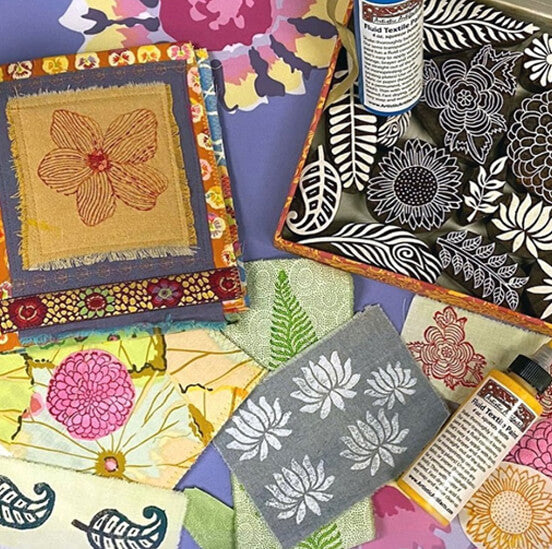Batik Panel Art Quilt with Sari Silk Border
After too much time on the road and dealing with some computer/technical issues in the shop, I recently took a much needed day off to spend in my studio.
I was inspired to work with our new Multicolored Sari Silk Fat Quarter assortment packs from India (featured in our most recent enewsletter): 12 beautiful colors! I decided to combine them with a wonderful panel handpainted by Bambang Dharmo. Here is my work in progress.

My first step was to trim my panel, creating straight square edges. I admit I used to skip this step, trying to use up every beautiful bit of the handpainted fabric. But after a result where the sewn side of the panel aren’t straight, I learned my lesson.
I wondered how to best sew the silk to the cotton panel? My solution was to apply a lightweight one-sided fusible interfacing meant for clothing that I found in my stash. Once the silk had the fusible on it, it made sewing it to the cotton panel a breeze. I also found some small pieces of Dupioni silk in bright colors in my stash, so I also prepped them with the interfacing and added them to my sari silks.
I cut the stack of silks with a ruler and my rotary cutter into strips approximately 1½" wide by the 6" wide. I lined them up by color on my work table, and then I started sewing.

My method might not seem like the best one to some, but it removes the stress of fretting over which color to put next to each other: I chain piece. I take 2 pieces of silk (different colors, of course) and chain sew a bunch, Then I cut the chain apart and add a third piece of silk and chain again. I continue to do this until I have a strip approximately 4-6 strips wide.
Then I press all the seams in the same direction and lay them out again. Next I start matching up these 6 pieces to make them longer 44” long about, and then trimmed to 4”wide.
I decided to add a small piping to the panel using the Groovin' Piping Trimming Tool. Once that was complete, I sewed the silk “piano keys” to the panel. I used my zipper foot to keep the piping tight.
 Sewing a chain-pieced silk border to the batik quilt panel. You can see the fusible interfacing on the back of the bright silk strips.
Sewing a chain-pieced silk border to the batik quilt panel. You can see the fusible interfacing on the back of the bright silk strips.My sewing order was top and bottom and then the two sides. I thought briefly about mitering the corners, but decided to just go with the strips as is.

Because I wanted the piping to go toward the panel, not the border, I did find that I had to watch my ironing. The correct direction was controlled when ironing on the reverse side and toward the border rather than the panel (above).
Below, you can see the piping set off the panel. I will trim the strips and edges, layer batting and backing, and finish this quilt off on another studio sewing day.








Leave a comment